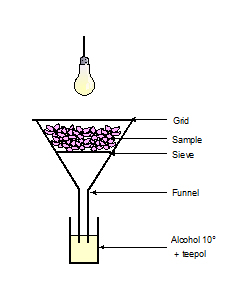Import inspections on Thrips palmi in France during the last 3 years
Since 1996, the French NPPO has tried to identify the main pathways of entry for Thrips palmi (EPPO A1 quarantine pest). Visual inspections for T. palmi are difficult due to the small size, mobility and behaviour of the insect. Inspection techniques using the 'Berlese' device have been developed and were found particularly useful to detect thrips on flowers and leafy vegetables. Due to the heat of the lamp, insects leave the plant samples and fall into an alcohol solution. However, 8 hours are necessary and only adult thrips can be reliably identified.

Berlese device from Bayart et al., 1999.
The results of import inspections on T. palmi made in the airports of Paris during the last 3 years are presented below.
Plant | Type of commodity | Origin | Nb of inspections with T. palmi adults identified | Nb inspections with T. palmi observed | Total nb of inspections made by pathway |
Orchidaceae | Cut flowers Plants with flowers | Thailand Singapore Malaysia Thailand | 41 6 1 1 | 47 14 5 2 | 284 147 112 11 |
Solanum melongena | Vegetable | Mauritius Dominican Republic Thailand | 6 2 3 | 13 6 83 | 34 14 230 |
Solanum torvum | Vegetable | Thailand | 1 | 4 | 23 |
Cucumis sativus | Vegetable | Mauritius | 1 | 0 | 1 |
Cucurbita maxima | Leaves | Mauritius | 8 | 6 | 16 |
Sechium edule | Leaves | Mauritius | 1 | 7 | 48 |
Momordica charantia | Vegetable | Dominican Republic Thailand | 2 4 | 10 40 | 12 88 |
Amaranthus viridus | Leaves | Mauritius | 3 | 5 | 8 |
Melia spp. | Leaves | Thailand | 1 | 6 | 17 |
Coriandrum spp. | Leaves | Thailand | 5 | 1 | 6 |
Unknown | Leaves | Thailand | 1 | - | - |
(Table from Bayart et al., 1999)
The main pathways identified are orchid cut flowers from Southeast Asia, fruits and vegetables (mainly Solanaceae and Cucurbitaceae) from Thailand, Mauritius and Dominican Republic. Considering the risks presented by such a polyphagous and harmful species, and as numerous interceptions of cut orchid flowers were made not only in France but also in many other European countries, the EU took a decision in February 1998 stating that orchids flowers from Thailand must have been produced at a place of production found free from T. palmi during the last 3 months or fumigated, and consignments must be accompanied by a phytosanitary certificate.
Sources
Bayart, J.D.; Reynaud, P.; Lemmonnier, R.; Cazaban, P. (1999) Eviter l'importation en Ile-de-France de Thrips palmi. Bilan de trois années de contrôle.
Phytoma - La Défense des Végétaux, no. 514, 53-55.
98/109/EC Commission decision of 2 February 1998 authorizing Member States temporarily to take emergency measures against the dissemination of Thrips palmi as regard Thailand.
Official Journal L 027, 03/02/1998 p47-48
Internet: htpp://europa.eu.int/euro-lex/en/lif/dat/1998/en_398D0109.html
